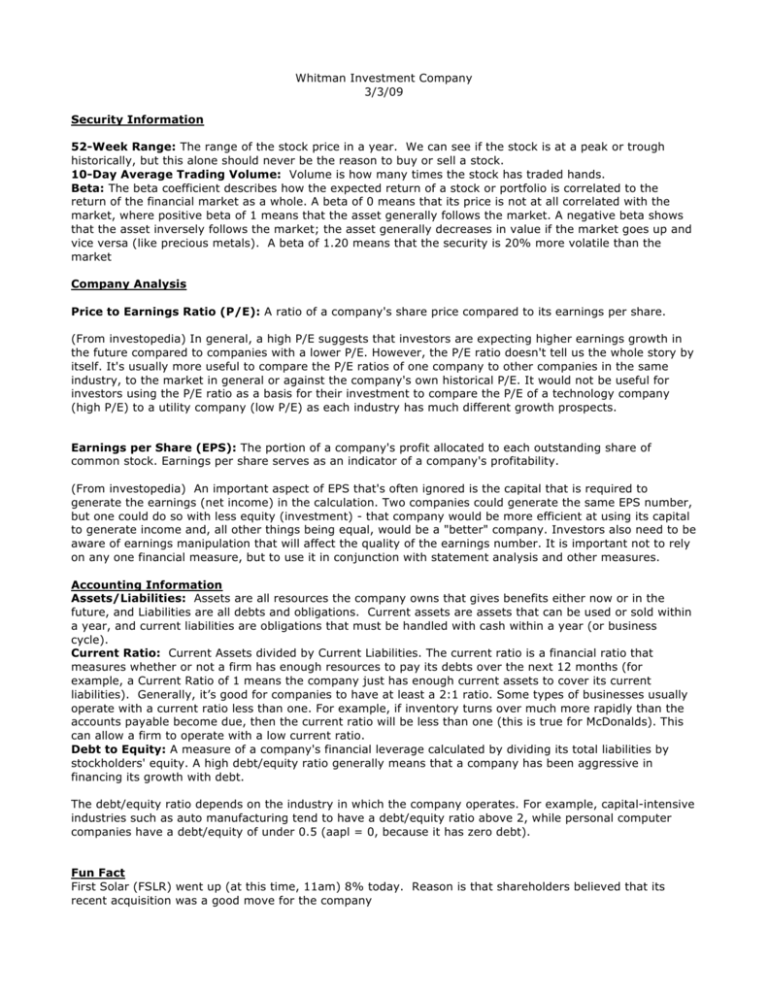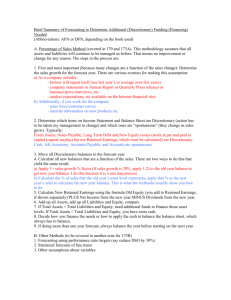Cheat Sheet
advertisement

Whitman Investment Company 3/3/09 Security Information 52-Week Range: The range of the stock price in a year. We can see if the stock is at a peak or trough historically, but this alone should never be the reason to buy or sell a stock. 10-Day Average Trading Volume: Volume is how many times the stock has traded hands. Beta: The beta coefficient describes how the expected return of a stock or portfolio is correlated to the return of the financial market as a whole. A beta of 0 means that its price is not at all correlated with the market, where positive beta of 1 means that the asset generally follows the market. A negative beta shows that the asset inversely follows the market; the asset generally decreases in value if the market goes up and vice versa (like precious metals). A beta of 1.20 means that the security is 20% more volatile than the market Company Analysis Price to Earnings Ratio (P/E): A ratio of a company's share price compared to its earnings per share. (From investopedia) In general, a high P/E suggests that investors are expecting higher earnings growth in the future compared to companies with a lower P/E. However, the P/E ratio doesn't tell us the whole story by itself. It's usually more useful to compare the P/E ratios of one company to other companies in the same industry, to the market in general or against the company's own historical P/E. It would not be useful for investors using the P/E ratio as a basis for their investment to compare the P/E of a technology company (high P/E) to a utility company (low P/E) as each industry has much different growth prospects. Earnings per Share (EPS): The portion of a company's profit allocated to each outstanding share of common stock. Earnings per share serves as an indicator of a company's profitability. (From investopedia) An important aspect of EPS that's often ignored is the capital that is required to generate the earnings (net income) in the calculation. Two companies could generate the same EPS number, but one could do so with less equity (investment) - that company would be more efficient at using its capital to generate income and, all other things being equal, would be a "better" company. Investors also need to be aware of earnings manipulation that will affect the quality of the earnings number. It is important not to rely on any one financial measure, but to use it in conjunction with statement analysis and other measures. Accounting Information Assets/Liabilities: Assets are all resources the company owns that gives benefits either now or in the future, and Liabilities are all debts and obligations. Current assets are assets that can be used or sold within a year, and current liabilities are obligations that must be handled with cash within a year (or business cycle). Current Ratio: Current Assets divided by Current Liabilities. The current ratio is a financial ratio that measures whether or not a firm has enough resources to pay its debts over the next 12 months (for example, a Current Ratio of 1 means the company just has enough current assets to cover its current liabilities). Generally, it’s good for companies to have at least a 2:1 ratio. Some types of businesses usually operate with a current ratio less than one. For example, if inventory turns over much more rapidly than the accounts payable become due, then the current ratio will be less than one (this is true for McDonalds). This can allow a firm to operate with a low current ratio. Debt to Equity: A measure of a company's financial leverage calculated by dividing its total liabilities by stockholders' equity. A high debt/equity ratio generally means that a company has been aggressive in financing its growth with debt. The debt/equity ratio depends on the industry in which the company operates. For example, capital-intensive industries such as auto manufacturing tend to have a debt/equity ratio above 2, while personal computer companies have a debt/equity of under 0.5 (aapl = 0, because it has zero debt). Fun Fact First Solar (FSLR) went up (at this time, 11am) 8% today. Reason is that shareholders believed that its recent acquisition was a good move for the company Appendix: On Yahoo Finance: Summary Key Statistics 1











